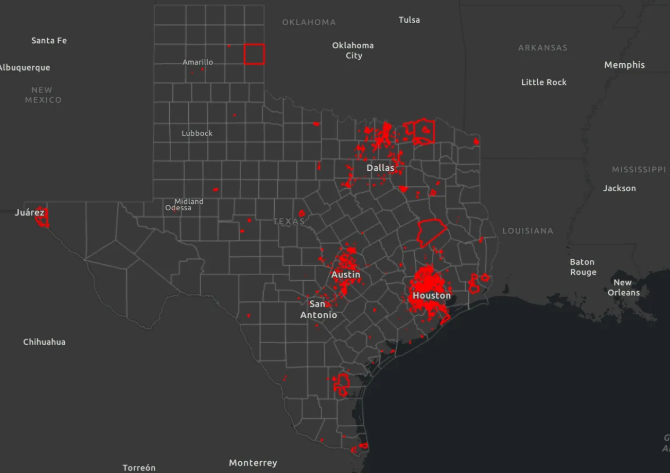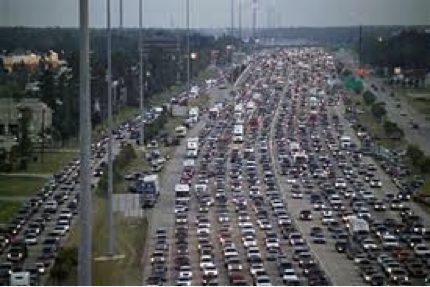Physical Address
304 North Cardinal St.
Dorchester Center, MA 02124
Physical Address
304 North Cardinal St.
Dorchester Center, MA 02124

Connor Tabarrok has an excellent new primer on Texas Municipal Utility Districts (MUDs), covering history, function, governance, and critiques.

During an urbanist twitter free-for-all last week, the thoroughly awesome term “liberty machines” was used to describe the virtues of the car. The claim was made that cars let individuals go wherever they want, whenever they want and are therefore a ‘freedom enhancing’ form of transit. This isn’t the first time I’ve heard this argument in libertarian(ish) circles. But it doesn’t tally with my experience and I’m not sure it makes any sense even within its own premise. A Personal Anecdote and a Couple Thoughts When I learned to drive way back when, it was in the great state of Texas where driving is basically a necessity. In that context, getting my license (and being economically fortunate enough to have access to a car) was certainly liberating for me after a fashion. Thinking back, though, I enjoyed far less mobility as a car bound teenager in suburban Houston than I do now living in Oakland, California. I walk to the grocery, take BART to work, bike to the gym, catch a Lyft to go out, and/or drive myself when the occasion demands. Most of my trips are multimodal and the integration of transit modes affords me far more freedom of movement than car use alone ever could. The biggest reason for this is that single occupancy vehicle use doesn’t scale as a stand alone system. Unpriced roadways are prone to hitting congestion points and, as readers of this blog are probably aware, adding lanes doesn’t help. When roads become clogged, and there are no viable alternatives, a reliance on cars becomes a constraint. And to respond to the idea that mass transit relies on government subsidies and car use does not…the technical term for that would be factually incorrect. Mass transit is more than capable of paying for itself and let’s just say highways don’t […]
Caos Planejado, in conjunction with Editora BEI/ArqFuturo, recently published A Guide to Urban Development (Guia de Gestão Urbana) by Anthony Ling. The book offers best practices for urban design and although it was written for a Brazilian audience, many of its recommendations have universal applicability. For the time being, the book is only available in Portuguese, but after giving it a read through, I decided it deserved an english language review all the same. The following are some of the key ideas and recommendations. I hope you enjoy. GGU sets the stage with a broad overview of the challenges facing Brazilian cities. Rapid urbanization has put pressure on housing prices in the highest productivity areas of the fastest growing cities and car centric transportation systems are unable to scale along with the pace of urban growth. After setting the stage, GGU splits into two sections. The first makes recommendations for the regulation of private spaces, the second for the development and administration of public areas. Reforming Regulation Section one will be familiar territory for any regular MU reader. GGU advocates for letting uses intermingle wherever individuals think is best. Criticism of minimum parking requirements gets its own chapter. And there’s a section a piece dedicated to streamlining permitting processes and abolishing height limits. One interesting idea is a proposal to let developers pay municipalities for the right to reduce FAR restrictions. This would allow a wider range of uses to be priced into property values and create the institutional incentives to gradually allow more intensive use of land over time. Meeting People Where They Are Particular to the Brazilian experience is a section dedicated to formalizing informal settlements, or favelas. These communities are found in every major urban center in the country and often face persistent, intergenerational poverty along with […]

Cities, for most of human history, were dumb. At least, that’s what the “smart cities” movement might lead you to believe. Over the past few years, a chorus of acquisitive multinational tech corporations, trend-savvy politicians, and optimistic developers—an odd mixture of former SimCity players, in all likelihood—has come to sing of technology’s potential to solve urban problems. Through implementation of technologies like augmented physical infrastructure, central command centers, and information exchange, proponents of smart cities argue that information technology offers new solutions to old problems like trash collection, public health, and traffic congestion. While the movement’s ideological variations are many and varied, a focus on top-down smart city solutions has ultimately distracted urban observers from the bottom-up smart city revolution that’s already underway. In his 2014 book Smart Cities: Big Data, Civic Hackers, and the Quest for a New Utopia, scholar Anthony M. Townsend paints a troubling picture of the former in Rio de Janeiro’s modestly titled Center for Intelligent Operations. Developed by IBM, the center acts as a hub for hundreds of surveillance cameras and sensors. At best, the center achieves little more than, in Townsend’s words, “looking smart.” At worst, the center seems to be a regression back to twentieth century centralization. Townsend’s explorations of Songdo, South Korea, a city purported to be both centrally-planned and smart, hardly quells these concerns. The discussion leaves the reader with a healthy skepticism of top-down smart city solutions. Other criticisms have made the top-down smart city feel less like something out of 1984 and more like something out of Terry Gilliam’s Brazil. In a couple of recent posts, Emily points out the roadblocks presented by poor incentives and a lack of market signals, both for politicians and high-ranking public servants. For similar reasons, both parties lack the incentives to implement […]
(Map of Robert Moses’ unbuilt proposals via “vanshnookenraggen.”) Sandy Ikeda blogs: If Moses were around today I don’t think he’d waste any time getting every major project he could think of “shovel ready” for hundreds of billions of stimulus money. While he’s no longer with us, I do fear that, with the incentive structure of the stimulus legislation and the knowledge problems that will accompany such massive and hurried construction, we’ll soon be seeing many incarnations of Moses rising up in cities around the country. So, not only will we have to live with ill-conceived mega-projects for decades to come, we’ll be subsidizing the birth of who-knows-how-many local despots who’ll be guiding urban policy for the foreseeable future.
Jim Powell’s latest article at Reason discusses the Tennessee Valley Authority, FDR’s most ambitious infrastructure program: It was heralded as a program to build dams that would control floods, facilitate navigation, lift people out of poverty, and help America recover from the Great Depression. Yet the reality is that the TVA probably flooded more land than it protected; much of the navigation it has facilitated involves barges of coal for coal-fired power plants; people receiving TVA-subsidized electricity have increasingly lagged behind neighbors who did not; and the TVA’s impact on the Great Depression was negligible. The TVA morphed into America’s biggest monopoly, dominating an 80,000 square mile region with 8.8 million people—for all practical purposes, it is a bureaucratic kingdom subject to neither public nor private controls. The article seems like it could easily be rescripted for just about any major government infrastructure project, especially our federal highway system. As a remedy for the Great Depression, the TVA didn’t work. It created no new wealth and, through taxation, transferred resources from the 98 percent of Americans who didn’t live in the Tennessee Valley to the two percent who did. Any spending that happened in the Tennessee Valley therefore was offset by the spending that didn’t happen elsewhere. Those taxes reduced net incomes. Much like any other complex public works project, it took an inordinate amount of time to build the TVA. Only three TVA dams were completed during the 1930s. The dams themselves were small—with less than one-twentieth the power-generating capacity of big western dams like Grand Coulee. Although the building process provided work for engineers and skilled construction workers—who earned above-average incomes—the dams simply came too late to have much impact on most people in the Tennessee Valley during the Great Depression. Nonetheless, expect governments to remake the same […]
As Washington debates how many hundreds-of-billions of the nearly trillion-dollar stimulus will go towards infrastructure or to other spending/tax cut schemes, pundits claim that spending billions on “shovel ready” public works projects can effectively create jobs that will lead to recovery. As readers probably know, I am skeptical that the anticipated spending could be activated so quickly. As Bruce Bartlett put it: Despite claims by the Conference of Mayors and the transportation lobby that there is as much as $96 billion in construction “ready to go,” the fact is that it takes a long time before meaningful numbers of workers can be hired for such projects. As a recent Congressional Budget Office study explains, “Practically speaking … public works involve long start-up lags. … Even those that are ‘on the shelf’ generally cannot be undertaken quickly enough to provide timely stimulus to the economy.” The prospects for unconventional projects such as alternative energy sources are even worse. The CBO calls them “totally impractical for counter-cyclical policy” because they take even longer to come online… Finally, the impact of increased public works spending on state and local governments cannot be ignored. Most federal transportation spending goes for projects initiated by them. When they think there is a chance that the federal government will increase its funding, they tend to cut back on their own spending in hopes that the feds will foot the bill. A study by economist Edward Gramlich found that the $2 billion appropriated by the Local Public Works Act of 1976 postponed $22 billion in total spending as state and local governments competed for federal funds and actually reduced GDP by $30 billion ($225 billion today). Meanwhile, proponents of infrastructure spending claim that Congress should sift through the shelved projects to identify those projects that will be economically […]
Recently, I came accross an article by Charles Johnson, who blogs at Rad Geek. The article had linked to a Market Urbanism post about how user fees and gas taxes fall well short of funding road use in the US. Charles’ article further debunks the Urbanism Legend asserted by free-market imposters that a free-market highway system would be similar to the system we see today. I like the post so much that I asked Charles about posting it at Market Urbanism. Charles requested that I, “indicate that the post is freely available for reprinting and derivative use under the terms of the Creative Commons Attribution-ShareAlike 1.0 license.” I am happy to comply, and must admit that I haven’t taken the time to acquaint myself with Creative Commons. So, here it is, in it’s original form, and feel free to read the comments in the link: Yes, Virginia, government roads really are government subsidized, and no, they don’t approximate freed-market outcomes by Charles Johnson, RadGeek.com When left-libertarians argue with more conventionally pro-capitalist libertarians about economics, one of the issues that often comes up is government control over roads, and the ways in which state and federal government’s control over roads has acted as a large subsidy for economic centralization and national-scale production and distribution networks (and thus, to large-scale “big box” retailers, like Wal-Mart or Best Buy, dependent on the crafty arrangement of large-scale cross-country shipping as a basic part of their business model). People who have a problem with this analysis sometimes try to dispute it by arguing that government roads aren’t actually subsidized — that heavy users of government roads are actually getting something that roughly approximates a freed-market outcome, because users of government roads pay for the roads they get, in proportion to how heavily they use them, because government […]
This post is part of an ongoing series featured on Market Urbanism called Urbanism Legends. The Urbanism Legends series is intended to expose many of the myths about development and Urban Economics. (it’s a play on the term: “Urban Legends” in case you didn’t catch that) Last week President-elect Obama announced some details of his economic stimulus package: Second, we will create millions of jobs by making the single largest new investment in our national infrastructure since the creation of the federal highway system in the 1950s. We’ll invest your precious tax dollars in new and smarter ways This further taxpayer subsidization, beyond currently insufficient highway revenue sources, of sprawl and auto-dependency seems to contradict Obama’s promise of “green jobs”. As Tyler Cowen remarks, “for better or worse you can consider the opposite of a carbon tax.” Furthermore, the Obama plan intends to fund the stimulus directly to states, as opposed to metro areas, which have historically received almost two-thirds of the funds directly. Certainly, Obama’s plan is not an urbanism-friendly plan, yet I consistently hear urbanists subscribing to and spreading the myth that jobs can be created by spending on infrastructure, and that these jobs will lead to economic recovery. Even if the job creation myth were true, and could stimulate the economy immediately, you would think urbanists would not sacrifice urbanist ideals for the sake of short-term recovery through their commitment to so-called progressive ideology. In his enduring 1961 classic, Economics in One Lesson, Henry Hazlitt addresses the long-standing myth about “creating jobs” through public works projects: A bridge is built. If it is built to meet an insistent public demand, if it solves a traffic problem or a transportation problem otherwise insoluble, if, in short, it is even more necessary to the taxpayers collectively than the things for which […]
While I sympathize with the theme and agree with regards to roadway spending and “conservative” hypocrisy, a recent article in the progressive The American Prospect takes a narrow-minded view of politics and urbanism, while throwing around broad generalizations about evolution and global warming to support their assertions: The Conservative Case for Urbanism In fact, one doesn’t have to be concerned about climate change at all in order to support such policies; values of fiscal conservatism and localism, both key to Republican ideology, can be better realized through population-dense development than through sprawl. Tom Darden, a developer of urban and close-in suburban properties, said Wednesday, “I’m a Republican and have been my whole life. I consider myself a very conservative person. But it never made sense to me why we would tax ordinary people in order to subsidize this form of development, sprawl.” Darden told the story of a road-paving project approved by North Carolina when he served on the state’s transportation board. A dirt road that handled just five trips per day was paved at taxpayer expense, with money that could have gone toward mass transit benefiting millions of people. “Those were driveways, in my view, not roads,” Darden said. I agree with Darden. However, so-called “progressives” fall into the same narrow minded trap when they support public transportation as a solution to global warming that “conservatives” fall into when they try to protect their auto-centric lifestyle. Many are really calling for more of the same top-down overspending on transportation infrastructure that will require a taxpayer bail out at some time in the distant future. Where is the rational voice trying to slow down overspending on all energy-reliant, sprawl-creating, redistribution of productive resources? While existing transit may be less bad environmentally in comparison to highways when looked at from a […]